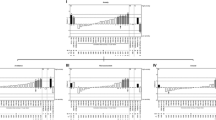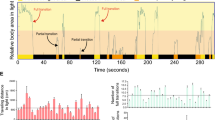Abstract
In a test battery consisting of an open-field arena, a light-dark box, a mirror-chamber box, an elevated plus maze, and an elevated square maze, 1,671 mice were tested, generating over 100 putative measures of anxiety in rodents. Quantitative trait loci (QTL) analysis was carried out on all measures, plus composite measures and phenotypic factor scores. Significant LOD scores were found for QTL on 17 chromosomes, with large and consistent QTL behavioral effects on chromosomes 1, 4, 7, 8, 14, 15, l8, and X. QTL on chromosomes 4 and 8 largely influence locomotor activity in both home cages and novel environments, whereas QTL on chromosomes 1, 15, and 18 influence anxiety-related behaviors. Five genetically separable, cross-test dimensions of anxiety could be identified: (i) the suppression of locomotor activity in low to moderately anxiogenic regions of the tests; (ii) a shift toward proportionally less time and activity spent in high-anxiogenic test areas; (iii) the suppression of rearing behavior; (iv) increased latency to enter novel areas; (v) increased autonomic responses, as assessed by defecation and urination. Patterns of QTL influence on cross-test composite scores were distinctive. For example, the QTL on chromosome 1 strongly influenced safe-area locomotor activity (LOD = 35) and autonomic responses (LOD = 16), whereas the QTL on chromosome 15 influenced the proportion of activity in high-anxiogenic areas (LOD = 16), latency to enter novel areas (LOD = 36) and rearing behavior (LOD = 57). Phenotypic factor analysis identified factors heavily loaded on single tests, rather than cross-test factors. The use of factor analysis or within-test principal components for data reduction before genetic analysis was less satisfactory than using genetic dissection methods on the original measures and logically derived composites.
Similar content being viewed by others
References
Aguilar, R., Gil, L., Flint, J., Gray, J. A., Dawson, G. R., Driscoll, P., Gimenez-Llort, L., Escorihuela, R. M., Fernández-Teruel, A., and Tobeña, A. (2002). Learned fear, emotional reactivity and fear of heights: A factor analytic map from a large F(2) intercross of Roman rat strains. Brain Res. Bull. 57:17-26.
Barlow, D. H. (2000). Unraveling the mysteries of anxiety and its disorders from the perspective of emotion theory. Am. Psychol. 55:1247-1263.
Belzung, C. (2001). Rodent models of anxiety-like behaviors: Are they predictive for compounds acting via non-benzodiazepine mechanisms? Curr. Opin. Invest. Drugs 2:1108-1111.
Belzung, C., and Le Pape, G. (1994). Comparison of different behavioral test situations used in psychopharmacology for measurement of anxiety. Physiol. Behav. 56:623-628.
Cattell, R. B. (1966). The meaning and strategic use of factor analysis. In R. B. Cattell (ed.), Handbook of Multivariate Experimental Psychology. Chicago: Rand McNally.
Collins, A. C., Miner, L. L., and Marks, M. J. (1988). Genetic influences on acute responses to nicotine and nicotine tolerance in the mouse. Pharmacol. Biochem. Behav. 30:269-278.
Collins, R. L. (1964). Inheritance of avoidance conditioning in mice: A diallele study. Science 143:1188-1190.
Costall, B., Jones, B. J., Kelly, M. E., Naylor, R. J., and Tomkins, D. M. (1989). Exploration of mice in a black and white test box: Validation as a model of anxiety. Pharmacol. Biochem. Behav. 32:777-785.
Crawley, J. N. (1985). Exploratory behavior models of anxiety in mice. Neurosci. Biobehav. Rev. 9:37-44.
Darvasi, A., and Soller, M. (1997). A simple method to calculate resolving power and confidence interval of QTL map location. Behav. Genet. 27:125-132.
DeFries, J. C. (1969). Pleiotropic effects of albinism on open field behaviour in mice. Nature 221:65-66.
DeFries, J. C., Gervais, M. C., and Thomas, E. A. (1978). Response to 30 generations of selection for open field activity in laboratory mice. Behav. Genet. 8:3-13.
DeFries, J. C., and Hegman, J. P. (1970). Genetic analysis of openfield behavior. In G. Lindzey and D. D. Thiessen (eds.), Contributions to Behavior Genetic Analysis:The Mouse as a Prototype. New York: Appleton-Century-Crofts.
DeFries, J. C., Hegmann, J. P., and Weir, M. W. (1966). Open-field behavior in mice: Evidence for a major gene effect mediated by the visual system. Science 154:1577-1579.
Fernandes, C., González, M. I., Wilson, C. A., and File, S. E. (1999). Factor analysis shows that female rat behavior is characterised primarily by activity, male rats are driven by sex and anxiety. Pharmacol. Biochem. Behav. 64:731-738.
Flaherty, C. F., Greenwood, A., Martin, J., and Leszczuk, M. (1998). Relationship of negative contrast to animal models of fear and anxiety. Anim. Learn. Behav. 26:397-407.
Flint, J. (2003). The analysis of quantitative trait loci that influence animal behaviour. J. Neurobiol. 54:46-77.
Flint, J., Corley, R., DeFries, J. C., Fulker, D. W., Gray, J. A., Miller, S., and Collins, A. C. (1995). A simple genetic basis for a complex psychological trait in laboratory mice. Science 269:1432-1435.
Gershenfeld, H. K., Neumann, P. E., Mathis, C., Crawley, J. N., Li, X., and Paul, S. M. (1997). Mapping quantitative trait loci for open-field behavior in mice. Behav. Genet. 27:201-210.
Gershenfeld, H. K., and Paul, S. M. (1997). Mapping quantitative trait loci for fear-like behaviors in mice. Genomics 46:1-8.
Gray, J. A. (1987). The Psychology of Fear and Stress. Cambridge: Cambridge University Press.
Gray, J. A., and McNaughton, N. (2000). The Neuropsychology of Anxiety. Oxford: OUP.
Hegmann, J. P., and DeFries, J. C. (1968). Open-field behavior in mice: Genetic analysis of repeated measures. Psychon. Sci. 13:27-28.
Henderson, N. (1979). Genetic correlations between brain size and some behaviors of housemice. In M. Hahn, C. Jensen, and B. Dudek (eds.), Development and Evolution of Brain Size. New York: Academic Press.
Henderson, N. D. (1989). Interpreting studies that compare high-and low-selected lines on new characters. Behav. Genet. 19:473-502.
Hogg, S. (1996). A review of the validity and variability of the elevated plus maze as an animal model of anxiety. Pharmacol. Biochem. Behav. 54:21-30.
Knott, S. A., and Haley, C. S. (2000). Multitrait least squares for quantitative trait loci detection. Genet. 156:899-911.
Lander, E., and Kruglyak, L. (1995). Genetic dissection of complex traits: Guidelines for interpreting and reporting linkage results. Nat. Genet. 11:241-247.
Landgraf, R., and Wigger, A. (2002). High vs. low anxiety-related behavior rats: An animal model of extremes in trait anxiety. Behav. Genet. 32:301-314.
Lincoln, S., Daly, M., and Lander, E. (1992). Mapping Genes Controlling Quantitative Traits with MAPMAKER/QTL 1.1. Cambridge, MA: Whitehead Institute Technical Report.
Lord, F. (1980). Applications of Item Response Theory to Practical Testing Problems. Hillsdale, N.J.: Erlbaum.
Nadeau, J. H., and Frankel, W. N. (2000). The roads from phenotypic variation to gene discovery: Mutagenesis versus QTLs. Nat. Genet. 25:381-384.
Pellow, S., Chopin, P., File, S., and Briley, M. (1985). Validation of open: Closed arms entries in an elevated plus maze as a measure of anxiety in the rat. J. Neurosci. Methods 14:149-167.
Preacher, K., and MacCallum, R. (2002). Exploratory factor analysis in behavior genetics research: Factor recovery with small sample sizes. Behav. Genet. 32:153-161.
Ramos, A., and Mormede, P. (1998). Stress and emotionality: A multidimensional and genetic approach. Neurosci. Biobehav. Rev. 22:33-57.
Rodgers, R. J. (1997). Animal models of 'anxiety': Where next? Behav. Pharmacol. 8:477-496.
Rodgers, R. J., and Cole, J. C. (1994). The elevated plus maze: Pharmacology, methodology and ethology. In S. J. Cooper (ed.), Ethology and Psychopharmacology. Chichester: Wiley.
Royce, J. R., Poley, W., and Yeudall, L. T. (1973). Behavior-genetic analysis of mouse emotionality. I. Factor analysis. J. Comp. Physiol. Psychol. 83:36-47.
Shepherd, J. K., Grewal, S. S., Fletcher, A., Bill, D. J., and Dourish, C. T. (1994). Behavioural and pharmacological characterisation of the elevated “zero-maze” as an animal model of anxiety. Psychopharmacology (Berl) 116:56-64.
Stoll, M., Cowley, A. W., Jr., Tonellato, P. J., Greene, A. S., Kaldunski, M. L., Roman, R. J., Dumas, P., Schork, N. J., Wang, Z., and Jacob, H. J. (2001). A genomic-systems biology map for cardiovascular function. Science 294: 1723-1726.
Toubas, P. L., Abla, K. A., Cao, W., Logan, L. G., and Seale, T. W. (1990). Latency to enter a mirrored chamber: A novel behavioral assay for anxiolytic agents. Pharmacol. Biochem. Behav. 35:121-126.
Trullas, R., and Skolnick, P. (1993). Differences in fear motivated behaviors among inbred mouse strains. Psychopharmacology 111:323-331.
Turri, M. G., Datta, S. R., DeFries, J., Henderson, N. D., and Flint, J. (2001a). QTL analysis identifies multiple behavioral dimensions in ethological tests of anxiety in laboratory mice. Curr. Biol. 11:725-734.
Turri, M. G., Henderson, N. D., DeFries, J. C., and Flint, J. (2001b). Quantitative trait locus mapping in laboratory mice derived from a replicated selection experiment for open-field activity. Genetics 158:1217-1226.
Van Abeelen, J. H., van der Kroon, P. H., and Bekkers, M. F. (1973). Mice selected for rearing behavior: Some physiological variables. Behav. Genet. 3:85-90.
Author information
Authors and Affiliations
Rights and permissions
About this article
Cite this article
Henderson, N.D., Turri, M.G., DeFries, J.C. et al. QTL Analysis of Multiple Behavioral Measures of Anxiety in Mice. Behav Genet 34, 267–293 (2004). https://doi.org/10.1023/B:BEGE.0000017872.25069.44
Issue Date:
DOI: https://doi.org/10.1023/B:BEGE.0000017872.25069.44




